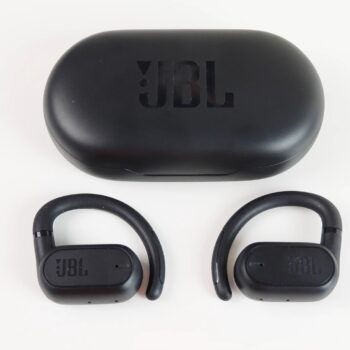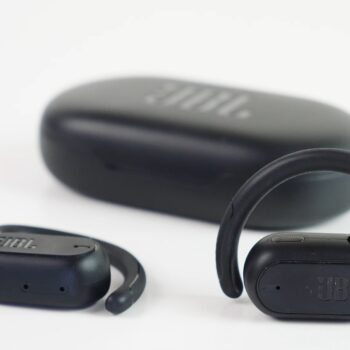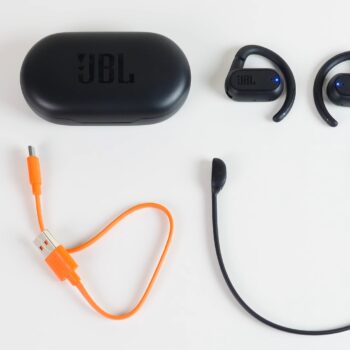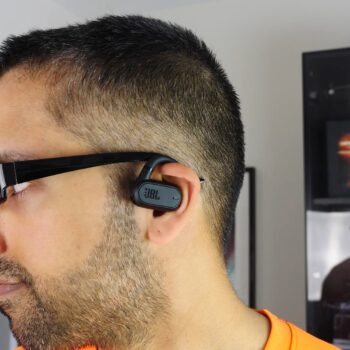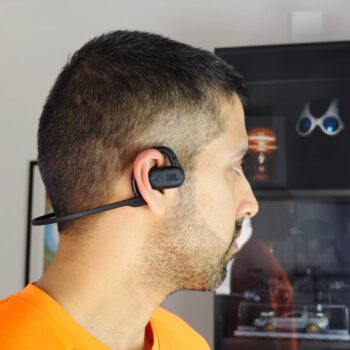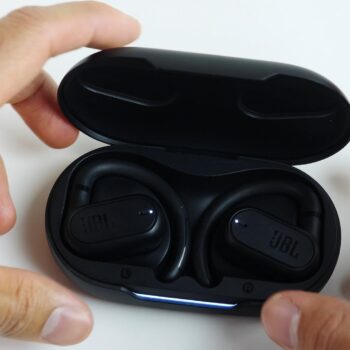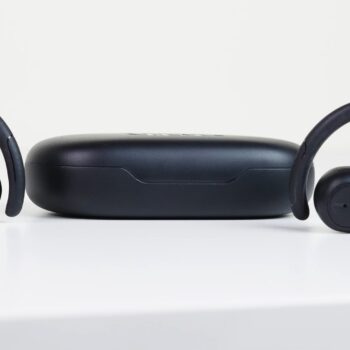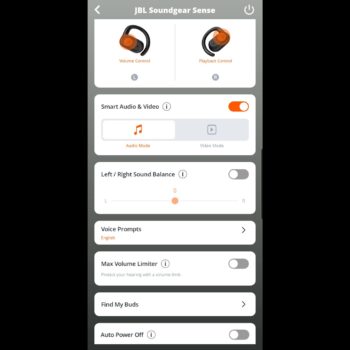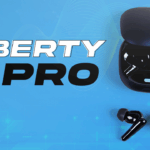Hey! Welcome to the review of JBL’s Sound Gear Sense. These are truly wireless open earbuds, meaning they let you always hear your surroundings. There’s no noise cancellation—passively or actively—so you’re always aware while listening.
Why does that matter? If you’re jogging, biking, or in an office where you need to stay alert, these are ideal. But if you want isolation, these aren’t for you.
Price
In Canada, they cost $199, while in the U.S., they’re $150, though they often go on sale, so watch for discounts.
Connectivity
They use Bluetooth 5.3, but JBL doesn’t list the range. In my testing, I got 25ft with one wall in between, which is decent, though many cheaper earbuds reach 50ft with multiple walls. There’s no official info on how many devices they remember, but I tested three before needing to re-pair. They also support dual connectivity, meaning you can connect to both a phone and a laptop. If a call comes in, laptop playback pauses, then resumes after the call.
Accessories
Included accessories are an optional neckband and an 8.5 inch USB-A to USB-C cable, though it’s not pure USB-C.
Like most headphone brands, there’s no power adapter, so you’ll need to use your phone charger or a computer.
Design & Comfort
The earbuds look fine—not the most stylish, but not bad either. They are large, which is obvious from the pictures on JBL’s website and even through the transparent packaging. If you’re buying them in-store, you’ll see their size firsthand. That includes seeing them on the attractive male model on the box and website, who is much nicer to look at than my own face. So, there’s that.
The design suits its purpose since they’re open earbuds meant to let you hear your surroundings. Unlike Sony’s open earbuds, which sit in your ear with an opening in the middle, these hook onto your ear and slide backward for a secure fit. I expected them to shake around during exercise, but they stayed firmly in place while jogging and working out.
For those who wear glasses, they can be a bit tricky to put on, but once in place, they stay secure and don’t interfere with the frames. They’re comfortable enough for long hours, and their IP54 rating means they’re dust, water, and sweat-resistant—perfect for workouts.
The earpiece is adjustable, allowing the ring to rotate for a snug fit, and the hook moves slightly to accommodate different ear shapes. They come in black and white.
The case, though large, is easy to keep track of. The size is expected given the earbuds themselves, but it’s not too thick or tall, making it manageable for bags or purses.
Controls
The controls are entirely touch-based across the surface of each earbud.
Tapping the left earbud once increases volume, while a double tap lowers it. However, you can’t repeatedly tap to decrease volume—it only lowers once per double tap, which is odd since there’s no triple-tap command or custom options in the app. It would make sense to allow continuous volume adjustment, especially when ads on YouTube or Spotify suddenly blast at full volume.
You know those ads that don’t make sense like, “Do you need a new dishwasher? Has yours stopped working? Then you need to buy a Peloton treadmill! That’s right. Why don’t you buy an overly expensive treadmill that you need to use with the subscription service? Best of all, it provides a little screen of sweaty people yelling at you to workout harder instead of watching your own YouTube content you might enjoy like Babbling Boolean channel (hint) or your own Netflix content that you actually enjoy. That’s right. Buy a peloton.”
Holding down an earbud activates your phone’s smart assistant. In my testing, Google Assistant on Android worked fine. No complaints there.
The right earbud controls playback: a single tap plays or pauses, a double tap skips to the next track, and a triple tap goes to the previous track. Touch sensitivity is excellent, and I never had issues with commands not registering.
There’s no passive play/pause, meaning removing the earbuds won’t automatically pause content. That’s not expected at this price, but worth mentioning.
Noise Cancelling
In case you skipped the intro of this article and jumped here, I’ll repeat it again. These do not support noise cancelling. These are open earbuds designed to let you hear your surroundings, so if you’re jogging or cycling, you’ll hear everything around you along with your music. If you want noise isolation, these aren’t for you.
Battery
Battery life is claimed to be six hours, but in my testing, I consistently got eight hours, which is a nice surprise.
JBL states the earbuds take two hours to recharge, but I consistently got 1.5 hours when placed in the case. The case itself takes 2.7 hours to fully recharge, JBL doesn’t state how long it takes to charge the case.
A fully charged case provides four full earbud charges, which JBL claims equals 24 hours of total playtime (six hours per charge). However, in my testing, I got 33 hours, far exceeding JBL’s estimate.
The earbuds magnetically snap into the case.
To charge the case, the USB-C port is at the back. Wireless charging isn’t supported, which is expected at this price, but worth mentioning.
Microphone Quality
The microphone quality in a quiet environment is decent for the price—not as good as newer laptop microphones, but clear enough for conversations.
In a loud setting, the microphones were surprisingly effective at reducing background noise. While speaking, background sounds were barely noticeable, though they became faintly audible when I paused. A clapping test did let noise through, but that’s expected with sudden loud sounds.
Where the microphone struggles is with wind noise. If you plan to use these outdoors—especially for cycling against the wind—phone calls may not sound great. If that’s a concern, check the YouTube video at the 8:44 mark for a real-world test.
Audio Quality
For audio codec support, they handle SBC and AAC. I tested them in a quiet environment to fully assess sound quality. Out of the box, the default flat profile is dull and lifeless. Using JBL’s preset equalizers drastically improves the experience.
A strange issue arises when adjusting bass manually. My custom bass-heavy equalizer degraded vocal clarity, while JBL’s bass preset kept vocals smooth and punchy. Even when I tried to replicate JBL’s bass settings manually, my version sounded worse. Some other earbuds and headphones have had similar quirks.
Since these are open-ear earbuds, bass naturally leaks, meaning they won’t deliver deep, immersive bass like in-ear or over-ear headphones. JBL’s extra bass and jazz presets work well, but these aren’t bass-heavy earbuds by design.
Increasing vocal clarity also presents challenges. JBL’s vocal preset kills bass entirely (their preset has bass reduced dramatically), making vocals clear but music lifeless. My custom settings didn’t ruin performance but didn’t enhance vocals much either, vocals stayed relatively the same.
Increasing the highs makes little difference, the quality sounds the same and nothing sound sharper.
You’re better off sticking with JBL’s flat, bass, or jazz presets, which work well enough. Custom sound profiles don’t perform great, but the preset equalizers make the audio just okay, not bad, but nothing special.
Wearing glasses doesn’t affect the fit or sound quality since the earbuds rest snugly in place. The frames don’t interfere, so there’s no noticeable difference.
Software
The app offers basic features, including the equalizer and control settings, but no control customization.
There’s an option to switch between audio and video modes but it made zero difference in my experience.
There’s a max volume limiter, which helps prevent hearing damage, but it feels overly restrictive. I wish the threshold were higher, though you can turn it off. The Find My Earbuds feature plays a loud tone if they’re misplaced, and there’s auto power-off support. Other than that, the app mostly consists of a quick start guide and factory reset options.
Conclusion
Overall, the Soundgear Sense is decent for what it’s designed to do—open earbuds that are comfortable and great for workouts, especially for cyclists or anyone needing awareness of their surroundings.
The audio performance is underwhelming, mainly due to the limited custom equalizer, though the presets help balance things out. Given these caveats, I feel they should be priced lower.
At retail price, they’re not amazing but not terrible, they’re just okay. If you’re looking for open earbuds with decent comfort and awareness, they’re worth considering.
That’s a wrap! Hope you found this review helpful.
Score:
7.5/10
Pros:
-Range
-Dual connect
-Multi-device memory
-Decent appearance
-Case design
-Comfortable
-Colour options
-Responsive controls
-Earbud battery
-Case battery
-USB-C charging port
-Just okay microphone
-Okay noise cancelling microphone
-Preset equaliser audio quality
-App
-IP54 rating
Cons:
-Retail (non-sale) price
-USB-A to USB-C cable
-Volume control function
-Microphone wind noise blocking
-Custom equaliser performance

